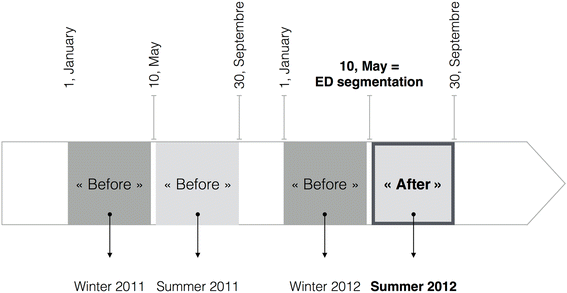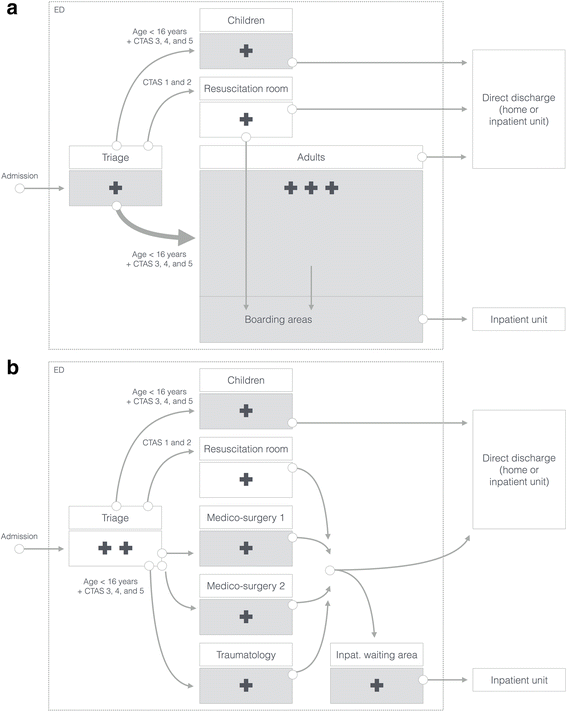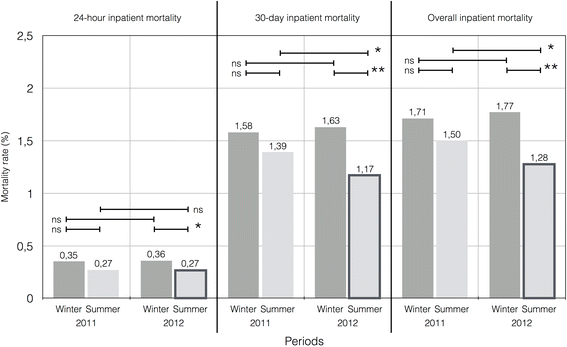The impact of emergency department segmentation and nursing staffing increase on inpatient mortality and management times
- PMID: 27430423
- PMCID: PMC4950694
- DOI: 10.1186/s12913-016-1544-x
The impact of emergency department segmentation and nursing staffing increase on inpatient mortality and management times
Abstract
Background: The aim of our study was to investigate the impact of a new organization of our emergency department (ED) on patients' mortality and management delays.
Methods: The ED segmentation consisted of the development of a new patient care geographical layout on a pre-existing site and changing the organization of patient flow. It took place on May 10, 2012. We did a before-after study in the ED of a university hospital, "before" (winter 2012) and "after" (summer 2012) reorganization by segmentation into sectors. All ED patients were included.
Results: Eighty-three thousand three hundred twenty-two patient visits were analyzed, 61,118 in phase "before", 22,204 during the phase "after". The overall inpatient mortality was 1.5 % during summer 2011 ("before" period), 1.8 % during winter 2012 ("before" period), 1.3 % during summer 2012 ("after" period) period (summer 2012 vs. winter 2012, OR = 0.72; 95 % CIs [0.61, 0.85], and summer 2012 vs. summer 2011, OR = 0.85; 95 % CIs [0.72, 0.99]). The mean (SD) time to first medical contact was 129 min (±133) during winter 2012 and 104 min (± 95) during summer 2012 (p < .05).
Conclusions: Our study showed a decrease in mortality and improvement in time to first medical contact after the segmentation of our ED and nursing staffing increase, without an increase in medical personnel. Improving patient care through optimizing ED segmentation may be an effective strategy.
Keywords: Emergency service; Hospital; Nursing staff; Organizations.
Figures



Similar articles
-
Effect of an independent-capacity protocol on overcrowding in an urban emergency department.Acad Emerg Med. 2009 Dec;16(12):1277-1283. doi: 10.1111/j.1553-2712.2009.00526.x. Epub 2009 Nov 12. Acad Emerg Med. 2009. PMID: 19912131
-
Hospitalist bed management effecting throughput from the emergency department to the intensive care unit.J Crit Care. 2010 Jun;25(2):184-9. doi: 10.1016/j.jcrc.2009.08.004. Epub 2009 Oct 13. J Crit Care. 2010. PMID: 19828284
-
Improving Emergency Department radiology transportation time: a successful implementation of lean methodology.BMC Health Serv Res. 2017 Sep 5;17(1):625. doi: 10.1186/s12913-017-2488-5. BMC Health Serv Res. 2017. PMID: 28870249 Free PMC article.
-
Comparison of methods for measuring crowding and its effects on length of stay in the emergency department.Acad Emerg Med. 2011 Dec;18(12):1269-77. doi: 10.1111/j.1553-2712.2011.01232.x. Acad Emerg Med. 2011. PMID: 22168190 Review.
-
[Management of the end of life in the emergency department: evaluation of a dedicated training course on emergency department practices at the CHU Ambroise Paré].Soins Gerontol. 2023 Jan-Feb;28(159):31-35. doi: 10.1016/j.sger.2022.12.011. Epub 2022 Dec 15. Soins Gerontol. 2023. PMID: 36717175 Review. French.
Cited by
-
Efficiency measures of emergency departments: an Italian systematic literature review.BMJ Open Qual. 2021 Sep;10(3):e001058. doi: 10.1136/bmjoq-2020-001058. BMJ Open Qual. 2021. PMID: 34493488 Free PMC article.
References
Publication types
MeSH terms
LinkOut - more resources
Full Text Sources
Other Literature Sources

